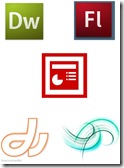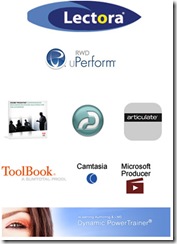E-Learning authoring tools are part of a larger organizational infrastructure and learning ecosystem which typically includes hardware, software, content delivery mechanisms, and processes that support the delivery and management of learning programs. This includes everything from hardware such as servers and workers’ desktop computers, software such as learning management systems (LMSs) and authoring applications, delivery mechanisms such as routers and network wiring, and services and processes such as systems administration and the help desk.
 Broadly speaking, an authoring tool is a software package which developers use to create and package content for delivery to end users.
Broadly speaking, an authoring tool is a software package which developers use to create and package content for delivery to end users.
More specifically, e-learning authoring tools enable trainers to integrate an array of media to create professional, engaging, interactive training content, and make use of digitized media assets, as well as learning objects from an existing course for reuse in a new one.
Typically, e-learning content developers integrate digital media including:
- Text
- Images
- Animations
- Audio
- Video
…to create e-learning content and courseware.
Since the term 'authoring tool' is somewhat non-specific, many  programs can be considered authoring tools, including web editors like Dreamweaver, Flash, PowerPoint and even content platforms like Adobe Connect provide the facility to create learning content.
programs can be considered authoring tools, including web editors like Dreamweaver, Flash, PowerPoint and even content platforms like Adobe Connect provide the facility to create learning content.
In 2003 Bill and Katherine Horton (E-learning Tools and Technologies, p.278) further refined this description and categorized the different types of tools into five domains of application (see Table 1) based upon the output that the tools are used to generate.
Table 1 Categories of Authoring Tools
| Category | Description |
| Course Authoring Tools | Expressly designed for creating e-learning. Such tools simplify the process of implementing instructional strategies, creating menus and navigation schemes, and authoring pages—without extensive technical knowledge. |
| Web Site Authoring Tools | Used in creating mark-up language (i.e. HTML, XML) for web pages, and linking them to produce entire websites. Such sites include courses, or material associated with courses. By including scripting, dynamic display effects, and connections to databases, these tools can create interactive e-learning content. |
| Testing and Assessment Tools | Used to create and manage assessments. These tools create true-false, multiple-choice, short-answer, text-entry, matching-lists, and other kinds of computer-scored tests. Some facilitate performance tracking and the ability to generate learner-related metrics and related reports. |
| Media Editors | Used for creating, editing, and "Web-readying" digital images, icons, photographs, animations, sounds, video, and other digital media used in e-learning |
| Content Conversion Tools | Used for transforming documents, presentations, graphics, audio, video, and other content to formats that can be used in e-learning and on the Web. |
| Web 2.0 Tools* | Used to facilitate communication, information sharing, interoperability, user-centered design, and collaboration on the Web. It has led to the development and evolution of web-based communities, hosted services, and web applications. Includes social-networking sites, video-sharing sites, wikis, blogs, mashups and folksonomies. |
Looking at Table 1, you'll see that I’ve asterisked the bottom category; it's a testament to the evolution of web technologies over the six short years since Horton & Horton’s text was published, a whole new category of authoring tools has emerged, so in my view it's justified to add this Read/Write Web (or Web 2.0) tools category to their list.
Significantly, the lines between applications specialized for learning, and applications intended for other uses have blurred. In addition to using traditional e-learning packages, learning professionals and organizations are engaging with the  concept of using using more generally available communication media such as synchronous web conferencing, instant messaging, mobile devices, video conferencing,online documents (and document collaboration), application sharing, knowledge management tools, and e-mail for training.
concept of using using more generally available communication media such as synchronous web conferencing, instant messaging, mobile devices, video conferencing,online documents (and document collaboration), application sharing, knowledge management tools, and e-mail for training.
These technologies can be used as stand-alone substitutes for traditional e-learning software, or to complement other learning channels and modalities. The advantage of using these types of tools is that support the ways the people in every organization and in every training situation already share knowledge: they have conversations, make presentations, perform demonstrations, make conference calls, and give lectures.
More...
___________
References:
Horton, W., and Horton, K. (2003). E-learning Tools and Technologies: A consumer's guide for trainers, teachers, educators, and instructional designers, Wiley Publishing, Inc., Indianapolis, Indiana.
--





3 comments:
Ka pai e Michael!
You have a nice range of types of authoring tools without giving away too many names of commercial packages. I think the crunch comes when budget is a consideration and knowledge of what packages can offer the individual is still young. Though experience counts for heaps, it's not always in abundance when needed to make budgetary decisions over purchase of these.
Catchya later
Thanks for putting some "grouping" to the various tools out there.
Hi Ken & Kim,
My pleasure - it seems such an obvious thing to categorize authoring tools according to output types, but it seems that less than a handful of products (Camtasia, Articulate, and the Adobe Suite) are so dominant in the e-learning content development space that we can forget that there are a range of other useful tools, and indeed many of them are either open source or free to use.
Michael
--
Post a Comment